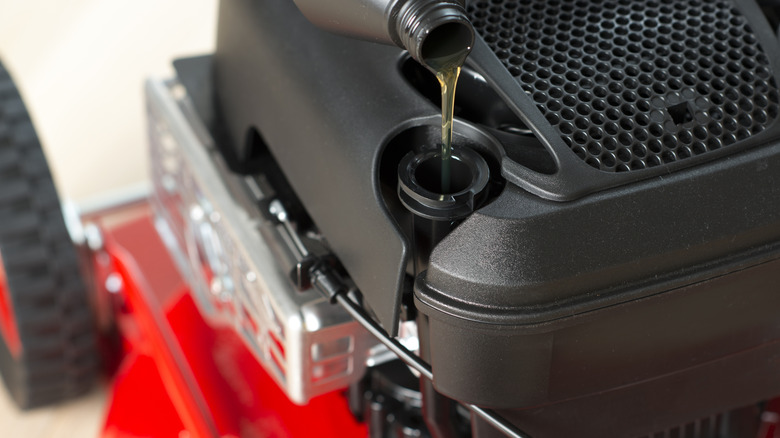What Kind Of Oil Do Most Lawn Mowers Use? (And Can You Use 5W30 Instead?)
Once the weather starts warming up and the grass starts growing at a rapid pace, it's time to get the lawn mower out. Assuming you don't have to go out and buy a new one — like the highly rated push mowers that cost under $500 — your current mower could likely use some preparation before spinning up for the first time in months. It could probably use a good cleaning, maybe a blade replacement, and some fresh gasoline or a charged battery to power it up. Odds are it'll need fresh oil, too, to keep every part within running smoothly.
For how infrequently they may be used, it's easy to forget that push lawn mowers, and riding mowers for that matter, require regular oil and filter changes. It's one of many lawn mower mistakes just about everyone makes. Just as important as remembering to handle this maintenance task, around every 50 use hours or so, is doing so with the correct type of oil. Push lawn mowers operate on small engines, so the correct oil type is needed. For the majority of push lawn mowers, SAE 30 oil is the right stuff. It's intended for use under warm, summer-like temperature conditions, with a recommended range between 40 and 100 degrees Fahrenheit.
SAE 30 oil is the most common lawn mower oil out there, but it's not the only one these machines can use. Others, such as SAE 5W30, can be used as well, though it should be noted that certain oil types are at their best under specific conditions.
A few other oil types can work in lawn mowers
More often than not, SAE 30 oil will serve your lawn mower just fine. With that said, if you want to try a different type of oil, you only have other types on-hand, or, most crucially, the climate calls for oil that performs better under certain conditions, you have options. The aforementioned SAE 5W30 is one such choice, with its synthetic variety providing strong protection at 100 degrees Fahrenheit and below, superior starting, and a lower rate of consumption to keep your mower running at its best longer. Non-synthetic SAE 5W30, on the other hand, is best reserved for specifically very cold conditions, 20 degrees and below.
Going beyond SAE 30 and SAE 5W30 engine oils, there are more types to consider. For instance, looking at SAE 10W30, we find an oil that is capable of handling a range of temperatures, from around 0 to well over 100 degrees. It's an excellent choice if you're concerned about starting your mower in the cold, but know that there's a chance the consumption rate could climb with this type. Meanwhile, there's 15W50 oil, which is ready to go at 20 degrees and up. This blend is typically reserved for situations of continuous use, like mowing multiple lawns a day for work. If you're ever unsure of which oil is best for your mower, you can always check your manual or consult the manufacturer to be safe.
A lot goes into picking the right oil for your mower. Fortunately, actually going about a lawn mower oil change isn't nearly as involved. Here's how it's done.
Changing the oil in a lawn mower
If you feel the need to put some fresh oil in your lawn mower, with a little effort, you can do it from the comfort of your home. With a container of your desired oil on hand, the first thing to is fire up your mower for about 15 minutes. This gets the old oil moving, ensuring it collects any dirt and debris that could be left behind otherwise. After the allotted time, you can turn the mower off and get to work.
1. Locate the spark plug wire on your mower and disconnect it.
2. Drain any gasoline from the mower, or cover the gas cap with a plastic bag to prevent any leakage.
3. If your mower has an oil drain plug, remove it with an oil pan underneath to catch the old oil. Otherwise, you can extract the oil from the dipstick tube or by using an oil extractor tool.
4. Once the old oil is out, replace the drain plug if necessary and add your fresh oil. The used oil should be disposed of properly and recycled through the likes of AutoZone or your trash collection service if they offer oil pickup.
5. Use the dipstick to check the oil's level, which should be between the two holes.
6. If it's right, put the oil cap back on and reattach the spark plug wire.
That's all it takes to replace a lawn mower's oil. So long as you've used the right kind for your model, you should have no trouble tackling yard cleanup.


